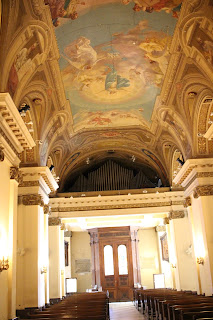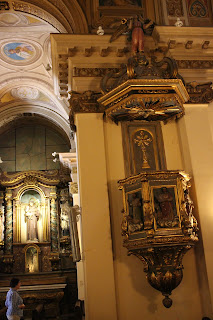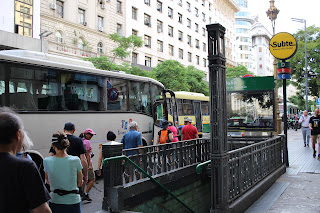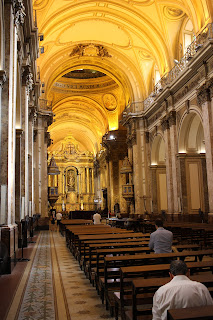On Sunday, March 5, 2023, we flew out of MSP on JetBlue 618 to JFK. The flight was 45 minutes late getting off, which had us worried, since our layover in New York was only supposed to be an hour and forty-one minutes, and we had to get from Terminal 5 to Terminal 8, which everything I read said would require leaving and re-entering the secured area. At least, we were already checked all the way through to Buenos Aires and wouldn't need to do anything at JFK except show our passports and boarding passes. Normally, we don't check luggage, but for this trip we would need a wider range of clothing, because we'd be in different climate zones, so we brought and checked (somewhat) larger suitcases.
In the end, we didn't have to go through security again, because American Airlines had a shuttle bus from Terminal 5 to Terminal 8, and we got to the gate just as our group was called for boarding.
The flight was long (around ten hours) and I felt like a sardine crammed into a can. Are plane seats getting narrower and closer together? Mary Joy slept some, with the help of a new neck pillow, but, as usual, I slept very little. I gave up on my neck pillow, since it tilted my head uncomfortably forward, and I refuse, as a matter of principal, to tilt my seat back onto the person behind me. The food was edible, but not much better than that.
We were met at the airport by a cab driver with an Overseas Adventure Travel sign. Usually, when we go on a tour, we arrange our own flights, so airport pickup isn't part of the tour package, but this time one of the selling points was that airfare was included, saving us $3,000. This was our first trip since China in 2002 where we did nothing on our own and were picked up and dropped off at the airport by the tour company, staying in their hands for the whole adventure.
After a 40-minute ride into downtown, the driver dropped us of at the Argenta Tower Hotel, around 11:30 a.m.. After lunch at the hotel restaurant (not great), we went next door, to look into the church we could see from our window, the Basilica of Nuestra Señora del Socorro. It dates from the mid-eighteenth century, as one can tell from its neo-classical style.
At 5 p.m. we met the Trip Experience Leader, an Argentine woman named Mechy (a nickname for "Mercedes"), and the other members of the group: 16 in all, including us--five married couples, three solo men, three solo women--an unusually balanced group. Age range: early 60s to early 80s (?). Geographic range: six from the west coast, six from the east coast, four in between.
After the introductory tour briefing, Mechy led us on an orientation walk in the neighborhood (Retiro). She pointed out a place to exchange money, though it was closed for the day. Argentina has severe economic problems, including 90% inflation, and its aattempts to gain control of currency flows has led to a complicated and ever-changing rate-of-exchange situation, including several different rates that depend on who is changing money and under what circumstances. During this trip, we found that the best rate (in Argentina, Chile was entirely different) was by changing U.S. $100-dollar bills at exchange bureaus. Second was using our Visa card. Third was changing less than $100 at exchange bureaus. Naturally enough, given the inflation, we did better toward the end of the trip, three weeks later.
The COVID-19 pandemic, as in Europe, made Argentina and Chile much more accepting of credit cards, even to the point that in some (but not all) restaurants you can put tips on the card instead of having to leave them in cash on the table. We ended up changing less than $200, and could easily have gotten by with less than that. Of course, part of this was due to the fact that many of our meal expenses were included in the tour.
A number of us joined Mechy for dinner at a restaurant named Broccolini. Mary Joy and I shared a good lasagna and a salad. This was our introduction to the huge portions that you get at Argentinian restaurants: even larger than in the U.S. We didn't learn that lesson, so we consistently ordered more food than we could eat. Argentines are very much into beef and not much into vegetables. We are not much into beef and very much into vegetables. This was not a foodie trip.
On Tuesday, March 7th, we got on a bus and rode down Avenida 9 de Julio (which Argentines claim is the widest avenue in the world, though, technically, it is three parallel streets. We got off at the Teatro Colón, the city's opera house, and from there walked down the street and crossed to the Obelisco, a monument commemorating the 400th anniversary of the founding of the city.
Then we crossed to the other side, got back on the bus and headed for the Plaza de Mayo.
The Plaza de Mayo is a typical Spanish colonial town square, like a Mexican zócalo. On one side is the Casa Rosada (Pink House), the presidential office building. On another side is the Cathedral. This particular square is known for the Mothers (and now, Grandmothers) of the Plaza de Mayo, who from nearly the beginning of the 1976-1983 military dictatorship, protested in the Plaza, demanding to know what had happened to their "disappeared" children. Around 30,000 people were kidnapped and murdered by the regime. The Mothers still protest there, keeping this horror fresh in memory, and hoping to find out more about the many whose bodies have not been recovered.
Mary Joy and I made a quick tour of the Cathedral, which had been the seat of Archbishop Jorge Bergoglio, now Pope Francis.
The group then walked a few blocks to the London City Cafe, where we heard a presentation by a man named Manuel, whose mother had been disappeared when he was 15 days old. Many years later, her body, in a mass grave, was identified by DNA analysis. It was very moving to hear this as well as the (somewhat) less horrifying experiences of the families of our guides, who were around the same age as Manuel.
We had coffee and medialunas (croissants) at the cafe, which was blanketed with reminders of the great Argentinian writer Julio Cortázar, who (or a reasonable facsimile thereof) is still seated at a window table, as apparently was his habit when alive. Coincidentally, I was then reading Cortázar's short story collection Bestiario. The stories are surreal, a little macabre, and have a sardonic sense of humor.
We got back on the bus and headed for La Boca, a gritty working-class neighborhood that is home to one of the city's two major soccer teams, the Boca Juniors. They have a natural and intense rivalry with the other team, River Plate, from the wealthier side of Buenos Aires. The Juniors' blue and yellow colors were derived many years ago, almost randomly, from the Swedish flag on a ship in port there. You do not wear River Plate's red and white jersey in La Boca, unless you want a good-natured (?) challenge. The Argentines, who won the World Cup a few months ago, are even more fanatical about futbol than about beef.
We were let free for around 45 minutes at La Boca's best-known attraction, the Caminito area, full of bright colors and art both serious and fanciful.


















































.JPG)













No comments:
Post a Comment